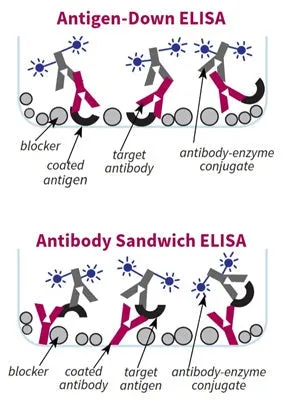ELISA Blocking Buffer
CAT:
436-643
Size:
1 L
Price:
Ask
- Availability: 24/48H Stock Items & 2 to 6 Weeks non Stock Items.
- Dry Ice Shipment: No








ELISA Blocking Buffer
Description:
Eliminate interference and nonspecific background associated with antibody-coated ELISA formats and sandwich ELISAs. ELISA Blocking Buffer (formerly known as Synblock) provides low background performance without the use of conventional cross-reactive protein additives.Label:
ICTType:
ELISA & Assay ReagentsAssay Protocol:
1. Dilute 5X Antibody Coating Buffer 1:5 with deionized water and mix for 15 minutes. As Antibody Coating Buffer is a 5X concentrate, crystalline precipitates may form in the bottle, especially when refrigerated. If this happens, gently warm the buffer until all crystals are dissolved. Do not let it boil., 2. Dilute your antibody into the coating buffer. Optimal coating concentration varies significantly from 0.1 µg/mL to 10 µg/mL., 3. Let the solution stir 10-15 minutes and pipette onto the plate. Optimal coating volume generally ranges between 50-200 µL per Well. ICT recommends coating antibodies onto Costar 96-Well EIA/RIA StripWell plate., 4. Once added to the plate, incubate the coating solution from 8-24 hours at room temperature protected from light. Minimize evaporation by individually covering each plate with a plate sealing cover, wrapping a stack in plastic wrap, or placing plates in a humidified storage box and covering., 5. Aspirate the coating solution., 6. Wash each Well twice with 1X ELISA Wash Buffer (catalog #652)., 7. Block the uncoated regions of the microplate Wells by pipetting 300 μL of blocking buffer (such as catalog #640, 64, or 643) into each Well., 8. Incubate 8-24 hours at room temperature., 9. Aspirate the blocking buffer., 10. The assay can be run at this point, or the plate can be dried and packaged for later use., 11. Dry the plate by letting it sit on the bench top from 8-24 hours while protected from light, or dry in a drying chamber under vacuum from 3 – 6 hours at room temperature. When dry, seal the plate in an air-tight foil pouch with a desiccant packet and store at RT or 2-8°C protected from light.Concentration:
1XpH:
pH: 7.4 at 1XAdditionnal Information:
ELISA & Assay Reagents; Blocking BuffersShipping Conditions:
Ships overnight (domestic), International Priority ShippingStorage Temperature:
2-8°CShelf Life:
Expires two years from date of manufactureTarget Description:
ELISA Blocking Buffer is designed to avoid false positives associated with animal proteins (e.g., BSA) and eliminate non-specific background noise in antibody-sandwich and antigen-down ELISAs without the use of conventional protein additives. By depositing inert, synthetic blocking molecules onto the plate, ELISA Blocking Buffer reduces non-specific binding of enzyme-labeled conjugates to the microtiter plate, enhancing the sensitivity of the assay. Its synthetic blockers also stabilize coated protein for improved retention of antigen epitope or antibody binding activity during long-term storage. ELISA Blocking Buffer contains an antimicrobial agent for room temperature blocking and long-term storage of dried plates at 2-8°C. ELISA Blocking Buffer works on all types of polystyrene plates except Immulon® II microplates. When blocking with ELISA Blocking Buffer, we recommend Corning® 96-Well EIA/RIA StripWell™ microplates (ICT catalog #25). When preparing plates, the antibody or antigen is typically coated using 50-200 µL of coating solution per Well. After coating, plates are normally washed to remove unbound proteins and then blocked using a larger volume of blocking buffer than was used for coating, such as 300 µL per Well. This ensures that all uncoated regions inside the Well are blocked. A 96-Well plate blocked using this method will require 28.8 mL of blocking solution. Allow approximately 10% extra blocking buffer to account for losses during pipetting.